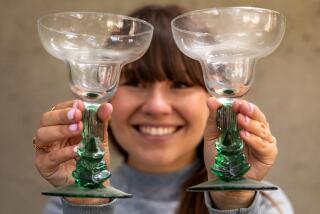Keepers or Weepers?
- Share via
Donna Jaffe of Brentwood had a feeling that the bronze statue she bought for $500 at an estate sale several months ago was worth more than she paid, but she wasn’t sure exactly how valuable it was.
She decided to find out by going on HGTV’s “Appraise It!” There she learned the bronze Pan was worth about $10,000.
“I saw the show and was wondering about the statue, so I gave them a call,” says Jaffe, who owns a business that finds antiques and other items for clients but says she has no formal training in antiques or appraising. Of the price, she says: “I was very pleased,” especially since having it independently appraised for the same amount.
Jaffe is one among the thousands across the country scrambling into closets, attics, basements and cupboards digging for antiques, collectibles or flea market or garage sale buys that just might be worth a fortune.
They’ve been spurred on by the proliferation of TV appraisal shows--PBS’ popular “Antiques Roadshow,” HGTV’s “Appraise It!” and “Appraisal Fair” and Pax TV’s “Treasures in Your Home.” These shows have captured audiences riveted by how much that Civil War-era pistol is worth or whether that Tiffany lamp is a fake. The prospect of easy dollars also is a big attraction.
Television has thus opened the arcane world of buying and selling antiques to the masses. Once reserved for the wealthy, the world of antiques--at least as defined by television--is now accessible to many.
The growing popularity of these programs “all started with the ‘Roadshow,’ ” says Sally Gould Wright, president of Richard Gould Antiques in Los Angeles, who worked as an appraiser when the show came to Los Angeles last year. “It has come across to the public as this great treasure hunt. I know people who aren’t particularly interested in antiques, but they watch it, they’re fascinated by it.”
The fascination, she says, is in both the information given and the monetary payoff when the appraisal is completed. It’s that heart-stopping moment when the garage sale-find table is actually worth six figures.
“I think by far, for the people who aren’t into antiques,” she adds, “it’s, ‘My gosh, look at how much money these things are worth!’ ”
If these shows offer a peek into the world of appraising, it’s only a peek--and that bothers some in the industry.
Although the shows’ formats vary, the premise is essentially the same: Someone brings an item on the show, tells what they know about it, and then the appraiser fills in the history and gives an approximate value. Viewers call the shows or send pictures of their items, or, in the case of “Roadshow,” simply show up as they did in Los Angeles in August 1998.
Appraisers often come from reputable auction houses such as Christie’s, Sotheby’s, Butterfield & Butterfield and others around the country.
Some professional appraisers have criticized the shows for making the appraisal process appear deceptively simple, skipping over the sometimes hours of tedious research required to make an accurate valuation.
Setting Up False Hope
And some dealers and appraisers believe the shows may set up false expectations for viewers who believe they own similar items.
“Finding-the-treasure-in-your-attic syndrome is just so attractive,” says Edwin W. Baker, executive vice president of the American Society of Appraisers in Washington, D.C., who says he’s most familiar with “Antiques Roadshow.”
“It’s a fairly universal dream. But the problem my members have with the show is that it tends to characterize the appraisal process as being really simple. You pick up an item, look at it, say what it is, and at auction it would bring you a certain amount of money. They [the shows] do acknowledge that there is more that goes on, but they don’t make a big deal of it.
“We would like to see them every once in a while do a piece on what an appraiser does, looking for comparable items, the investigation and research that needs to be done to see if it’s a real piece or a fake, and that’s not something that happens in three minutes. We get a lot of e-mails saying, ‘I have something--what is it worth?’ as opposed to, ‘Where can I get an appraisal?’ ”
Nancy Escher of Nancy Escher Inc. would also like to see the valuation process taken more seriously. The Beverly Hills-based appraiser of fine art, rare books and manuscripts says, “When you do an appraisal, you need to be able to provide support, a narrative. I’m working on a case involving a 19th century liturgical property. I don’t know anything about the Russian Orthodox church, but I can find out who the experts are, go to international sources, and build a bibliography. And my appraisal will provide all that.”
Appraisals from experts such as Escher aren’t cheap: She charges $200 an hour with a $1,600-per-day rate per appraiser, plus travel and expenses.
Sotheby’s does not charge for an auction estimate (not a formal appraisal) if someone intends to sell an item through the auction house (however, the seller is not obligated to do so). The house does charge for a formal appraisal, and that fee is based on the number of items, whether travel is needed, the number of people needed to do the appraisal, and the research involved.
Paying for Expertise
Clients pay for expertise built on years of education and work in such places as galleries, antique stores, museums, and auction and appraisal houses. Research can involve delving into library and museum sources, talking to experts in various fields and tracking down recent auctions to see what similar items have sold for.
Appraisers also caution that the auction process is a gamble. Just because something sold for $50,000 at one auction doesn’t mean it will sell for the same amount at another. Auction prices aren’t as predictable as retail markets since they’re based on what people are willing to pay. Provenance, authenticity, condition, rarity and current consumer interest all are factors in how much something can fetch.
(And, with the advent of Internet auction sites such as EBay, sellers don’t even have to go through traditional auction houses. They can put items up for bid from the comfort of their living rooms.)
Producers of the various shows defend their methods and their appraisers.
Thea Flaum, executive producer of HGTV’s “Appraisal Fair,” says her show includes segments on related books and resources, and adds: “An experienced appraiser has a developed eye, and they know what they’re looking at. Our jewelry appraisers have demonstrated how to calculate the carat weight of a gemstone, and our art experts show how you can look at a painting with a black light to see what’s underneath.
“Most of the time they don’t need to do research, but they do check a database to see what the most recent auction prices were for an item. Occasionally they’ll check books or make a phone call. It’s an unfair expectation that appraisers know everything all the time, but I think really good appraisers know a lot.”
“Appraise It!” associate producer Avelino Pombo admits, “There are certain things we have to leave out unfortunately [such as researching an item’s authenticity and recent auction prices] due to time constraints. But a lot of people mail photographs beforehand to the appraisers, and they do the research.”
And an appraiser going through volumes or making a phone call doesn’t exactly make for great television.
Giving a Wrong Impression
Antique dealer and appraiser Wright believes “there is certainly more to the appraisal process than [what’s shown on TV]. But with 30 years in the business, I can look at something and say it’s ‘X’ and worth ‘Z.’ But there’s another area [in which] I think the shows give the wrong impression, and that’s that people think everything they have is worth lots of money. Out of 3,000 people who come to the ‘Roadshow,’ you see far fewer on the show [each week features about 15 guests]. You don’t see all the people with saucers worth $5.”
The shows typically do not follow what happens to the items after the on-air appraisals. It’s unclear how many people keep or try to sell the items. “Appraise It!” uses the auction house Butterfield & Butterfield exclusively, and guests of the show can sell their items through the house, although only a small percentage do. On “Treasures in Your Attic” guests can put their items up for bid immediately through a live online auction. The “Roadshow” did a follow up on a Federal card table purchased at a garage sale for $25 and appraised on the show in January 1998 at $200,000 to $250,000. It was auctioned by Sotheby’s the same month for $491,000.
Of her on-air experience, Donna Jaffe, who has not sold her statute, says, “I saw nothing of what they used to appraise it, and I really don’t want to look at the process. I’m sure they read books on the subject.
“I get a kick out of those shows,” she adds. “Every now and then I’ll watch it with my 12-year-old son. He loves seeing someone who paid four cents for something that’s worth a million dollars. He thinks, ‘Wow, maybe that will happen to me!’ ”
“People have things passed down, and they haven’t been given any proper information about it,” says Pombo of “Appraise It!” “People just don’t pass down the information they should to the next generation. And I think these shows are a good way of helping people learn what they don’t know. The money aspect is kind of fun for them--like winning the lottery to some degree. There are a lot of people who come in and find out their items aren’t worth as much as they expected, but because it’s been in the family, it’s very sentimental. It’s a double bonus if it’s worth something.”
Arguably the liveliest of the appraisal shows is Pax TV’s “Treasures in Your Attic,” a live hour-long broadcast that includes on-air appraisals, games and information segments on antiques and collectibles. Perhaps its biggest appeal is its Web link; “Treasures” is hooked up to Collectingchannel.com. There is a live Web cast, and viewers can bid on items they see on the show.
Pax TV’s Bill Scott, president of programming, says an appraisal show suited the channel’s family-friendly programming mandate.
“People like to go to flea markets, antique shows, yard sales. It struck us as it strikes a lot of people--it’s interesting, even if you don’t buy anything. . . . We wanted to implement it in a way it hadn’t been done before and take the chance that you can marry television and the Internet, and we did it.”
Adds executive producer Larry Ferber: “It’s a healthy thing to do. We live in a consumer-oriented society. It’s not surprising that McDonald’s has been marketing stuff for the last 20 years. Hopefully you can learn something from the show. A couple of weeks ago we had African American collectibles from the Civil War. It makes people aware of what African Americans did at that time.”
Jeannine Stein can be reached by e-mail at socalliving@latimes.com.
More to Read
The complete guide to home viewing
Get Screen Gab for everything about the TV shows and streaming movies everyone’s talking about.
You may occasionally receive promotional content from the Los Angeles Times.






